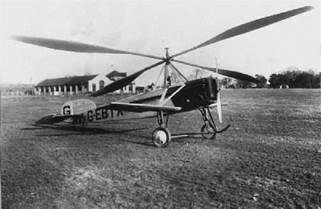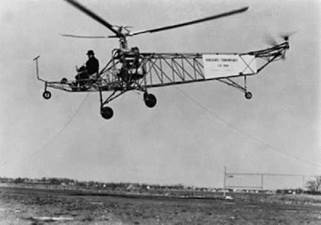Second World War Era
In December 1941 Igor Sikorsky flew his VS 300 helicopter design – see Figure 1.7 to a world endurance record of over 1 hour. It was fitted with collective and cyclic pitch on the main rotor and had a system of rotors at the tail. The torque reaction was provided by a vertical tail rotor and a horizontally aligned second rotor provided adjustment in pitch. In January 1942 an improved VS 300 flew for the first time. Designated the XR4 it was the forerunner of the R4 which was the first production helicopter outside of Germany. It was also the only
|
|
|
Figure 1.7 Vought Sikorsky VS300 |
helicopter operated by the USA during the Second World War and became known as the Hoverfly in the UK.
In 1943 the Doblhoff WNF 342 emerged. It used tip-jet drive with fuel being pumped from tanks in the fuselage along hollow rotor blades and burnt at the tips.
In October 1943 the R4 (designated HNX-1) became the first helicopter to be accepted by the US Navy.
In 1944 the Flettner rotor appeared on the Kolibri FL282 and the German Ministry of Defence placed an order for 1000 aircraft. This type of twin rotor is seen today in the Kaman Huskie and KMax helicopters and consists of two identical rotors, rotating in opposite senses. They have rotor shafts placed close together – laterally – and inclined outwards enabling the rotors to turn without any blade clashing.
January 1944 recorded the first mercy mission when a R4 US Coast Guard helicopter flew blood plasma to aid 100 crew members injured in an explosion on a US Navy destroyer.
September 1945 saw the first helicopter flight across the English Channel when a German Crew flew a Fa 223 Druck (Dragon) to Airborne Force Experimental Establishment. This was a large utility helicopter with two rotors placed on outriggers.
During the period of the Second World War, Sikorsky produced 600 airframes of their XR4, XR5 and XR6A variants before VJ Day on 2 September 1945.













